warning TESLA MODEL S 2014 Quick Guide (North America)
[x] Cancel search | Manufacturer: TESLA, Model Year: 2014, Model line: MODEL S, Model: TESLA MODEL S 2014Pages: 44, PDF Size: 5.31 MB
Page 7 of 44
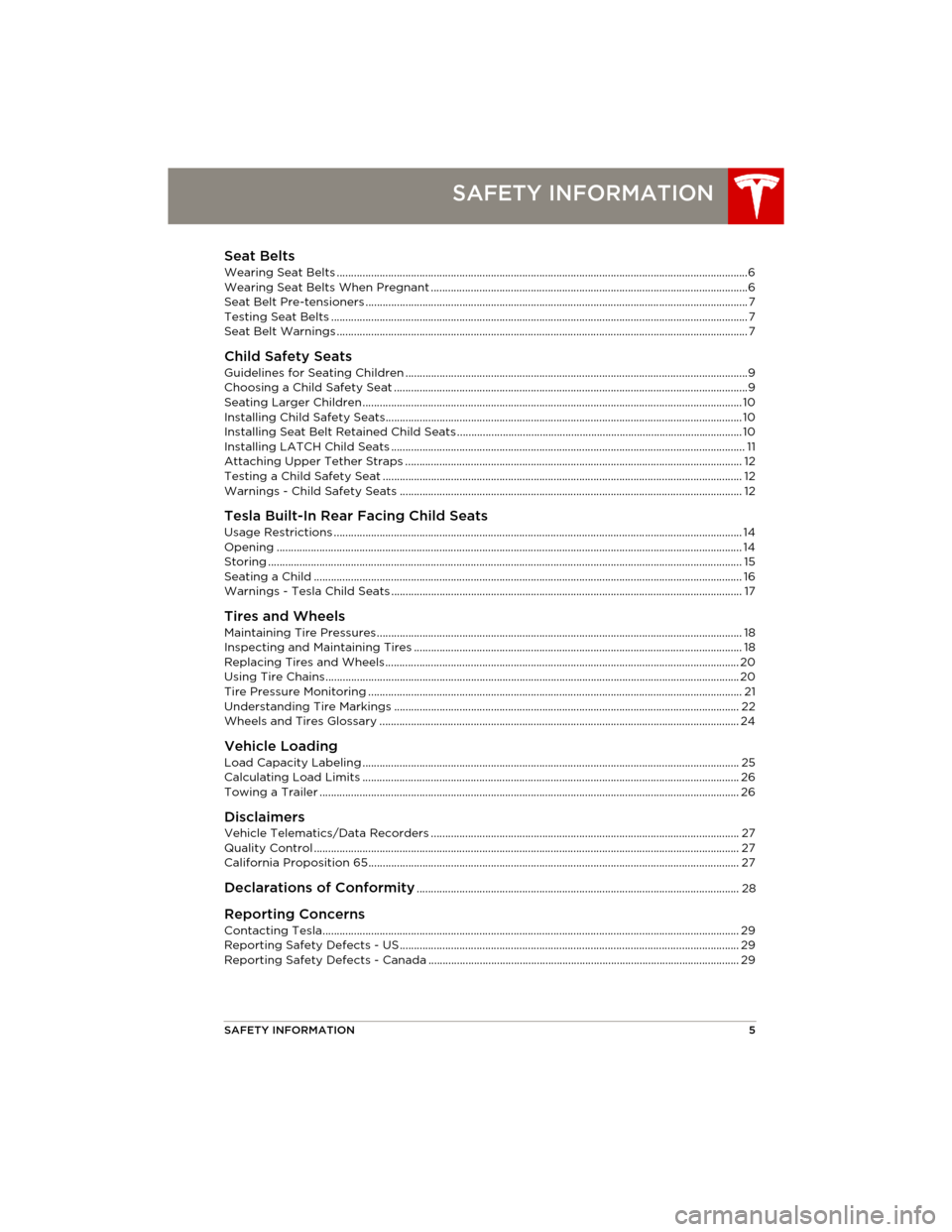
SAFETY INFORMATION5
SAFETY INFORMATION
Seat Belts
Wearing Seat Belts ................................................................................................................................................6
Wearing Seat Belts When Pregnant ........ ..................................................................... .................. ................6
Seat Belt Pre-tensioners ....................................................................................................... ............................... 7
Testing Seat Belts ............................................................................................................. ..................................... 7
Seat Belt Warnings ............................................................................................................. ................................... 7
Child Safety Seats
Guidelines for Seating Children ................................................................................................ ........................9
Choosing a Child Safety Seat ................................................................................................... .........................9
Seating Larger Children ........................................................................................................ ............................. 10
Installing Child Safety Seats.................................................................................................. ........................... 10
Installing Seat Belt Retained Child Seats ...................................................................................... .............. 10
Installing LATCH Child Seats ................................................................................................... ......................... 11
Attaching Upper Tether Straps .......................................................................................... ............................ 12
Testing a Child Safety Seat .................................................................................................... .......................... 12
Warnings - Child Safety Seats .................................................................................................. ...................... 12
Tesla Built-In Rear Facing Child SeatsUsage Restrictions ............................................................................................................................................... 14
Opening .......... .............................................................................................................. ........................................... 14
Storing ........................................................................................................................ .............................................. 15
Seating a Child ................................................................................................................ ...................................... 16
Warnings - Tesla Child Seats ................................................................................................... ........................ 17
Tires and WheelsMaintaining Tire Pressures ................................................................................................................................ 18
Inspecting and Maintaining Tires ............................................................................................... .................... 18
Replacing Tires and Wheels.... ......................................................................................... ............................... 20
Using Tire Chains.............................................................................................................. ................................... 20
Tire Pressure Monitoring ....................................................................................................... ............................ 21
Understanding Tire Markings .................................................................................................... ..................... 22
Wheels and Tires Glossary ... ............................................................ ....................................... ........................ 24
Vehicle Loading
Load Capacity Labeling ......................................................................................................... ........................... 25
Calculating Load Limits ..... ................................................................................................... ............................ 26
Towing a Trailer ............................................................................................................... .................................... 26
DisclaimersVehicle Telematics/Data Recorders .............................................................................................. .............. 27
Quality Control ................................................................................................................ ..................................... 27
California Proposition 65..................................... ............................................................................................. 27
Declarations of Conformity................................................................................................................. 28
Reporting Concerns
Contacting Tesla............................................................................................................... ................................... 29
Reporting Safety Defects - US .................................................................................................. ..................... 29
Reporting Safety Defects - Canada .............................................................................................. ............... 29
Model S Quick Guide - NA Rev C.book Page 5 Wednesday, December 18, 2013 12:40 PM
Page 8 of 44
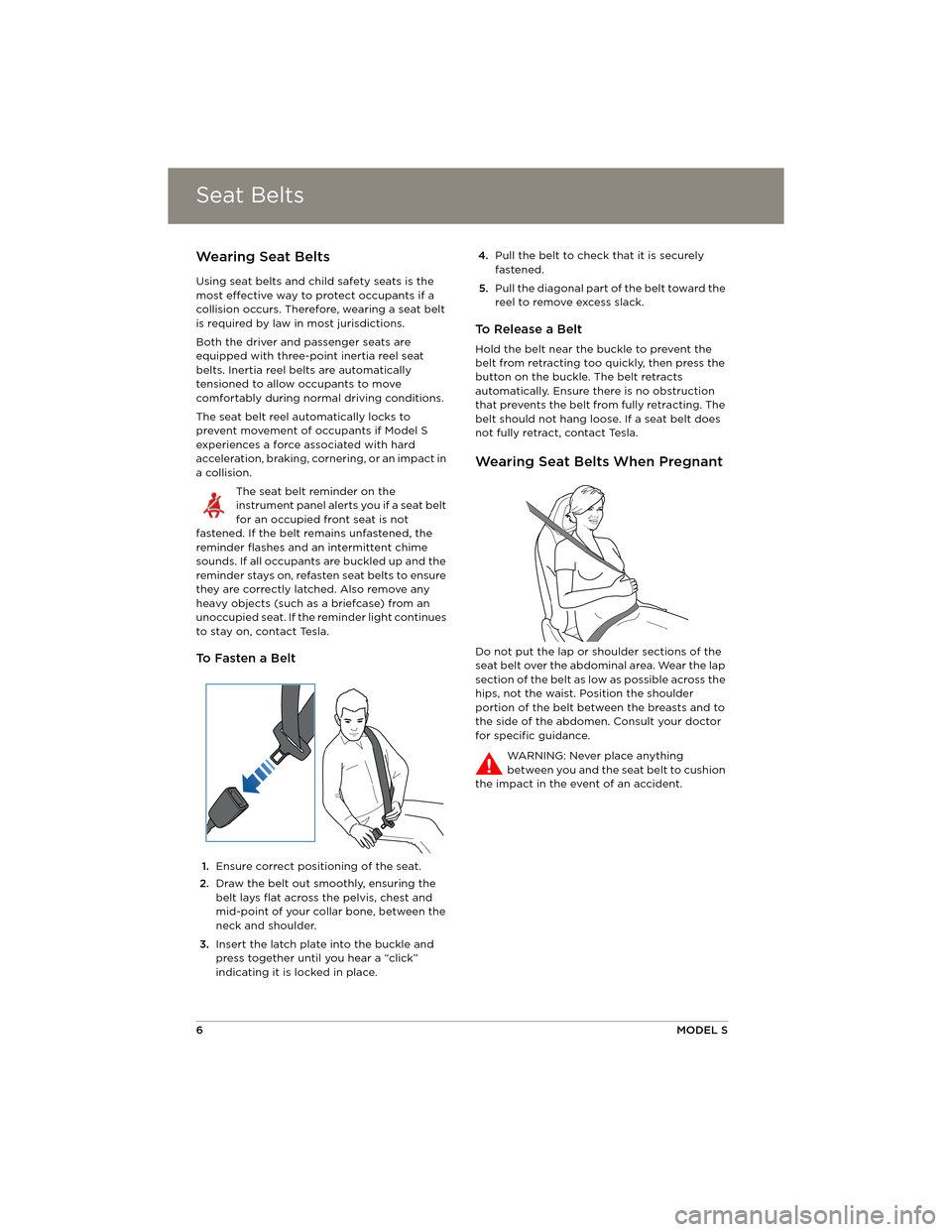
Seat BeltsSeat Belts
6MODEL S
SAFETY INFORMATION
Seat BeltsWearing Seat Belts
Using seat belts and child safety seats is the
most effective way to protect occupants if a
collision occurs. Therefore, wearing a seat belt
is required by law in most jurisdictions.
Both the driver and passenger seats are
equipped with three-point inertia reel seat
belts. Inertia reel belts are automatically
tensioned to allow occupants to move
comfortably during normal driving conditions.
The seat belt reel automatically locks to
prevent movement of occupants if Model S
experiences a force associated with hard
acceleration, braking, cornering, or an impact in
a collision.
The seat belt reminder on the
instrument panel alerts you if a seat belt
for an occupied front seat is not
fastened. If the belt remains unfastened, the
reminder flashes and an intermittent chime
sounds. If all occupants are buckled up and the
reminder stays on, refasten seat belts to ensure
they are correctly latched. Also remove any
heavy objects (such as a briefcase) from an
unoccupied seat. If the reminder light continues
to stay on, contact Tesla.
To F a s t e n a B e l t
1. Ensure correct positioning of the seat.
2. Draw the belt out smoothly, ensuring the
belt lays flat across the pelvis, chest and
mid-point of your collar bone, between the
neck and shoulder.
3. Insert the latch plate into the buckle and
press together until you hear a “click”
indicating it is locked in place. 4.
Pull the belt to check that it is securely
fastened.
5. Pull the diagonal part of the belt toward the
reel to remove excess slack.
To Release a Belt
Hold the belt near the buckle to prevent the
belt from retracting too quickly, then press the
button on the buckle. The belt retracts
automatically. Ensure there is no obstruction
that prevents the belt from fully retracting. The
belt should not hang loose. If a seat belt does
not fully retract, contact Tesla.
Wearing Seat Belts When Pregnant
Do not put the lap or shoulder sections of the
seat belt over the abdominal area. Wear the lap
section of the belt as low as possible across the
hips, not the waist. Position the shoulder
portion of the belt between the breasts and to
the side of the abdomen. Consult your doctor
for specific guidance.
WARNING: Never place anything
between you and the seat belt to cushion
the impact in the ev ent of an accident.
Model S Quick Guide - NA Rev C.book Page 6 Wednesday, December 18, 2013 12:40 PM
Page 9 of 44

Seat Belts
SAFETY INFORMATION7
Seat Belt Pre-tensioners
The front seat belts are equipped with
pre-tensioners that work in conjunction with
the airbags in a severe frontal collision. The
pre-tensioners automatically retract both the
seat belt anchor and the seat belt webbing,
reducing slack in both the lap and diagonal
portions of the belts, resulting in reduced
forward movement of the occupant. If the
pre-tensioners and airbags did not activate in
an impact, this does not mean they
malfunctioned. It usually means that the
strength or type of force needed to activate
them was not present.
WA R N I N G : O n c e t h e s e a t b e l t
pre-tensioners have been activated, they
must be replaced. After any accident, have the
airbags, seat belt pre-tensioners and any
associated components checked and, if
necessary, replaced.
Testing Seat Belts
To confirm that seat belts are operating
correctly, perform these three simple checks on
each seat belt.
1. With the seat belt fastened, give the
webbing nearest the buckle a quick pull.
The buckle should remain securely locked.
2. With the belt unfastened, unreel the
webbing to its limit. Check that unreeling is
free from snags, and visually check the
webbing for wear. Allow the webbing to
retract, checking that retraction is smooth
and complete. 3.
With the webbing half unreeled, hold the
tongue plate and pull forward quickly. The
mechanism should lock automatically and
prevent further unreeling.
If a seat belt fails any of these tests, contact
Tesla immediately.
Seat Belt Warnings
WARNING: Seat belts should be worn by
all occupants at all times, even if driving
for a very short distance. Failure to do so
increases the risk of injury or death if an
accident occurs.
WARNING: Secure small children in a
suitable child safety seat (see page 9).
Always follow the child safety seat
manufacturer's instructions when installing.
WARNING: Ensure that all seat belts are
worn correctly. An improperly worn seat
belt increases the risk of injury or death if an
accident occurs (see page 6).
WARNING: Do not wear seat belts over
hard, fragile or sharp items in clothing,
such as pens, keys, eyeglasses, etc. The
pressure from the seat belt on such items can
cause injury.
WARNING: Seat belts should not be worn
with any part of the strap twisted.
WARNING: Each seat belt assembly must
be used by one occupant only. It is
dangerous to put a seat belt around a child
being carried on an occupant’s lap.
WARNING: Seat belts that have been
worn in an accident must be inspected or
replaced by Tesla, even if damage to the
assembly is not obvious.
WARNING: Seat belts that show signs of
wear (such as fraying), or have been cut
or damaged in any way, must be replaced by
Te s l a .
WARNING: Avoid contaminating a seat
belt’s components with any chemicals,
liquids, grit, dirt or clea ning products. If a seat
belt fails to retract or latch into the buckle, it
must be replaced immediately. Contact Tesla.
WARNING: Do not make modifications or
additions that can prevent a seat belt
mechanism from taking up slack, or that can
Model S Quick Guide - NA Rev C.book Page 7 Wednesday, December 18, 2013 12:40 PM
Page 10 of 44
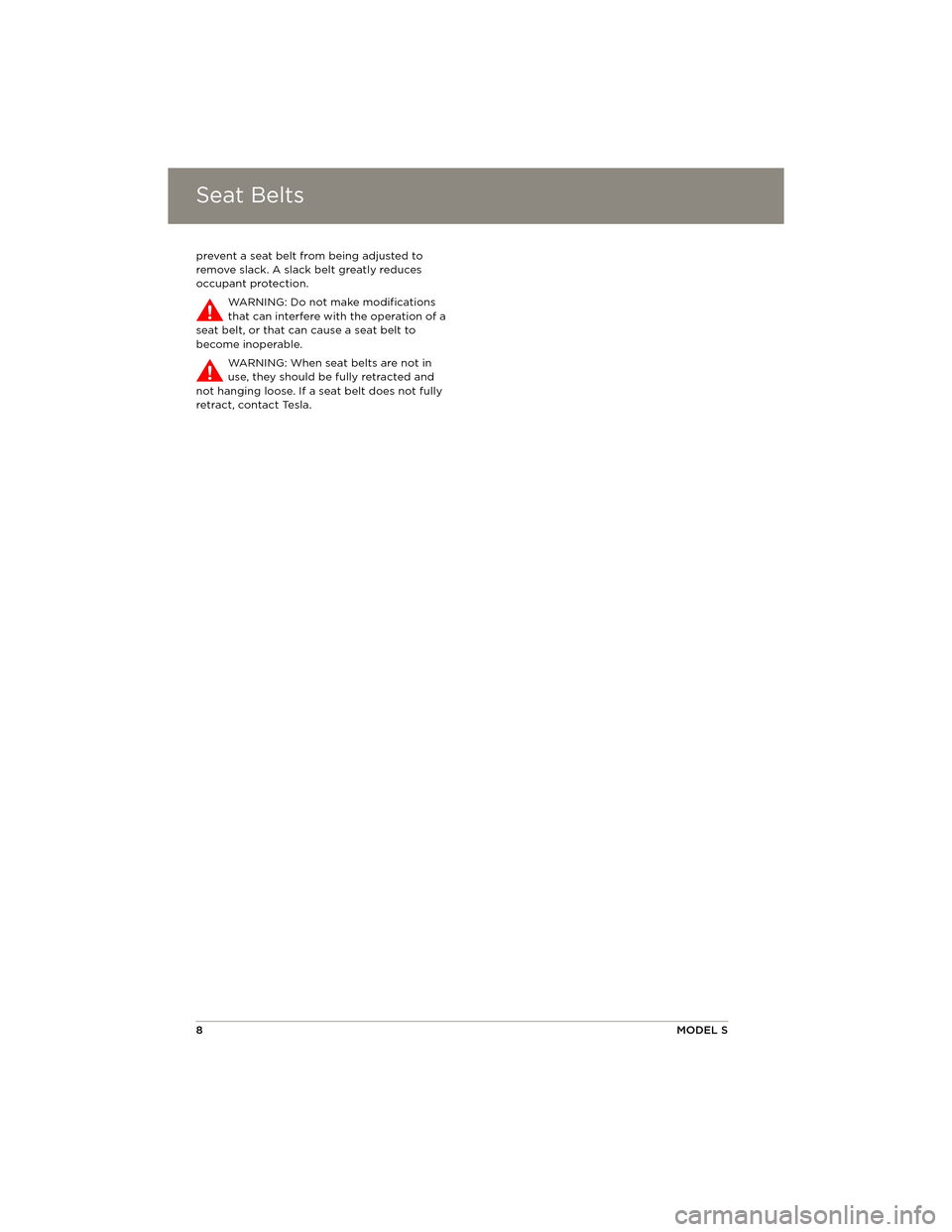
Seat BeltsSeat Belts
8MODEL S
prevent a seat belt from being adjusted to
remove slack. A slack belt greatly reduces
occupant protection.
WARNING: Do not make modifications
that can interfere with the operation of a
seat belt, or that can cause a seat belt to
become inoperable.
WARNING: When seat belts are not in
use, they should be fully retracted and
not hanging loose. If a seat belt does not fully
retract, contact Tesla.
Model S Quick Guide - NA Rev C.book Page 8 Wednesday, December 18, 2013 12:40 PM
Page 14 of 44
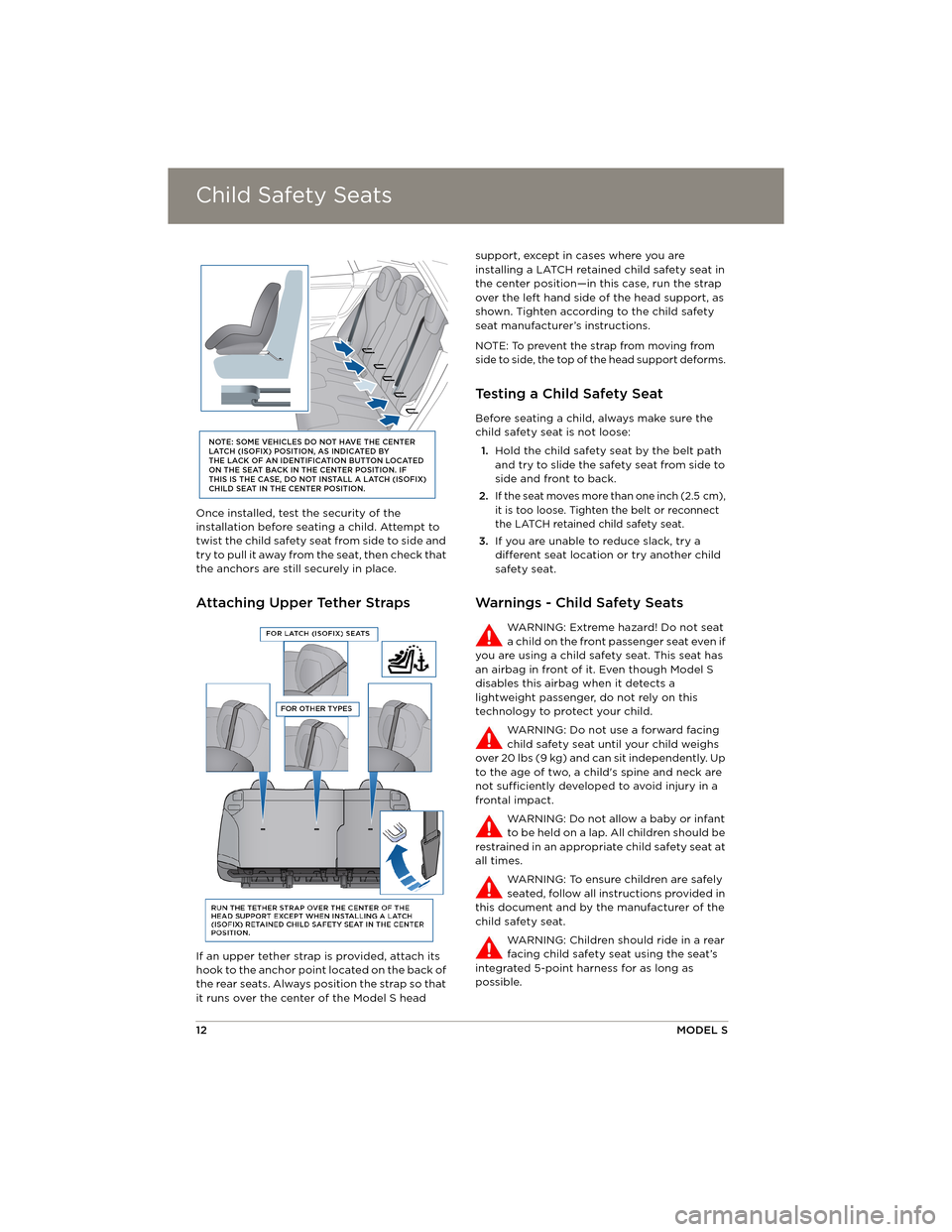
Child Safety SeatsChild Safety Seats
12MODEL S
Once installed, test the security of the
installation before seating a child. Attempt to
twist the child safety seat from side to side and
try to pull it away from the seat, then check that
the anchors are still securely in place.
Attaching Upper Tether Straps
If an upper tether strap is provided, attach its
hook to the anchor point located on the back of
the rear seats. Always position the strap so that
it runs over the center of the Model S head support, except in cases where you are
installing a LATCH retained child safety seat in
the center position—in this case, run the strap
over the left hand side of the head support, as
shown. Tighten according to the child safety
seat manufacturer’s instructions.
NOTE: To prevent the strap from moving from
side to side, the top of the head support deforms.
Testing a Child Safety Seat
Before seating a child, always make sure the
child safety seat is not loose:
1. Hold the child safety seat by the belt path
and try to slide the safety seat from side to
side and front to back.
2.
If the seat moves more than one inch (2.5 cm),
it is too loose. Tighten the belt or reconnect
the LATCH retained child safety seat.
3. If you are unable to reduce slack, try a
different seat location or try another child
safety seat.
Warnings - Child Safety Seats
WARNING: Extreme hazard! Do not seat
a child on the front passenger seat even if
you are using a child safety seat. This seat has
an airbag in front of it. Even though Model S
disables this airbag when it detects a
lightweight passenger, do not rely on this
technology to protect your child.
WARNING: Do not use a forward facing
child safety seat until your child weighs
over 20 lbs (9 kg) and can sit independently. Up
to the age of two, a child's spine and neck are
not sufficiently developed to avoid injury in a
frontal impact.
WARNING: Do not allow a baby or infant
to be held on a lap. All children should be
restrained in an appropriate child safety seat at
all times.
WARNING: To ensure children are safely
seated, follow all instructions provided in
this document and by the manufacturer of the
child safety seat.
WARNING: Children should ride in a rear
facing child safety seat using the seat’s
integrated 5-point harness for as long as
possible.
Model S Quick Guide - NA Rev C.book Page 12 Wednesday, December 18, 2013 12:40 PM
Page 15 of 44
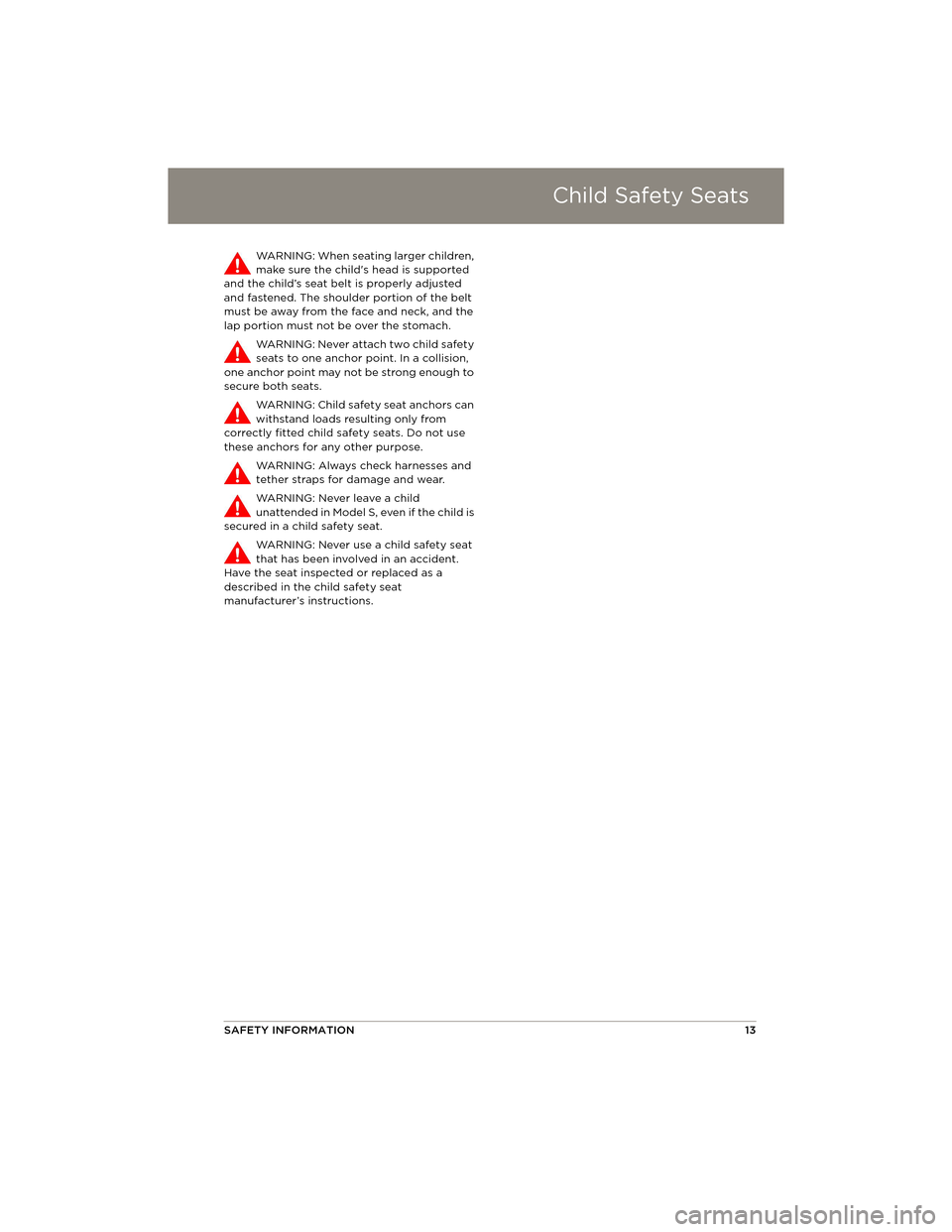
Child Safety Seats
SAFETY INFORMATION13
WARNING: When seating larger children,
make sure the child's head is supported
and the child’s seat belt is properly adjusted
and fastened. The shoulder portion of the belt
must be away from the face and neck, and the
lap portion must not be over the stomach.
WARNING: Never attach two child safety
seats to one anchor point. In a collision,
one anchor point may not be strong enough to
secure both seats.
WARNING: Child safety seat anchors can
withstand loads resulting only from
correctly fitted child safety seats. Do not use
these anchors for any other purpose.
WARNING: Always check harnesses and
tether straps for damage and wear.
WARNING: Never leave a child
unattended in Model S, even if the child is
secured in a child safety seat.
WARNING: Never use a child safety seat
that has been involved in an accident.
Have the seat inspected or replaced as a
described in the child safety seat
manufacturer’s instructions.
Model S Quick Guide - NA Rev C.book Page 13 Wednesday, December 18, 2013 12:40 PM
Page 19 of 44

Tesla Built-In Rear Facing Child Seats
SAFETY INFORMATION17
Warnings - Tesla Child Seats
WARNING: The Tesla built-in rear facing
seats are child restraint systems and must
only be used for children over 37” (94 cm) tall
and weighing between 35 and 77 lbs (16.2 to
35.2 kg).
WARNING: Do not use supplemental
child restraint systems, including booster
seats, in the Tesla built-in rear facing child seats.
WA R N I N G: A l ways e n s u re t h at t he to p o f
the child’s head cannot touch the
vehicle’s headliner and that the child is seated
comfortably with the seat belts correctly
fastened.
WARNING: Follow all instructions and
heed all warnings related to the rear
facing child seats. Failure to do so can
compromise occupant safety.
WARNING: Read all safety warnings and
labels attached to the seats.
WARNING: Do not leave children
unattended in Model S, even if the child is
secured in a child safety seat or a Tesla built-in
rear facing child seat. In hot weather, the
interior temperature can reach dangerous
levels that can result in dehydration, serious
injury or death.
WARNING: Do not remove or replace the
fabric on a Tesla built-in rear facing child
seat. The covers are an integral part of the
restraint’s performance and should not be
removed or replaced with any other type than
those supplied by Tesla.
WARNING: If the Tesla built-in rear facing
child seats have been used in an accident,
they must be inspected or replaced by Tesla,
even if damage is not obvious.
WARNING: Before allowing a child to ride
in the Tesla built-in rear facing child seats,
check that the seat is securely held in the
upright position by trying to pull the seat back
toward you.
WARNING: Do not remove the built-in
rear facing child seats for any reason,
including cleaning. To ensure safety of
occupants, removal and installation must be
performed by qualified Tesla service
technicians. WARNING: Do not make modifications or
additions that can interfere with the
operation of the Tesla built-in rear facing child
seats.
WARNING: To prevent injury, ensure all
loose items (bags, luggage, etc.) are
secured. In an accident, or during hard braking
and sharp turns, loose items could cause injury.
Model S Quick Guide - NA Rev C.book Page 17 Wednesday, December 18, 2013 12:40 PM
Page 20 of 44

Tires and WheelsTires and Wheels
18MODEL S
Tires and WheelsMaintaining Tire Pressures
Keep tires inflated to the pressures shown on
the Tire and Loading Information label located
on the driver’s door pillar (even if it differs from
the pressure printed on the tire itself).
The Tire Pressure indicator light does not
immediately turn off when you adjust tire
pressure. After inflating the tire to the
recommended pressure, you must drive over 25
mph (40 km/h) for more than 10 minutes to
activate the Tire Pressure Monitoring System
(TPMS), which turns off the Tire Pressure
indicator light.
If the indicator light flashes for one minute
whenever you power on Model S, a fault with
the Tire Pressure Monitoring System (TPMS) is
detected (see page 21).
Checking and Adjusting Tire Pressures
Follow these steps when tires are cold and
Model S has been stationary for over three
hours:
1. Remove the valve cap.
2. Firmly press an accurate tire pressure
gauge onto the valve to measure pressure. 3.
If required, add air to reach the
recommended pressure.
4. Recheck pressure by removing and
reattaching the tire gauge.
5. If you added too much air, release air by
pressing the metal stem in the center of the
valve.
6. Recheck the pressure with the tire gauge
and adjust if necessary.
7. Replace the valve cap to prevent dirt from
entering. Periodically check the valve for
damage and leaks.
WARNING: Under-inflation is the most
common cause of tire failures. It can
cause a tire to overheat, resulting in severe tire
cracking, tread separation, or blowout, which
causes unexpected loss of vehicle control and
increased risk of injury . Under-inflation also
reduces Battery range and tire tread life.
WARNING: Check tire pressures using an
accurate pressure gauge when tires are
cold. It takes only one mile of driving to warm
up the tires sufficiently to affect tire pressures.
Parking the vehicle in direct sunlight or in hot
weather can also affect tire pressures. If you
must check warm tires, expect increased
pressures. Do not let air out of warm tires in an
attempt to match recommended cold tire
pressures. A hot tire at or below the
recommended cold tire inflation pressure is
dangerously under-inflated.
WARNING: Do not use any tire sealant
other than the type provided in a Tesla
tire repair kit. Other types can cause tire
pressure sensors to malfunction. If your
Model S did not include a tire repair kit, you can
purchase one from Tesla Motors.
Inspecting and Maintaining Tires
Regularly inspect the tread and side walls for
any sign of distortion (bulges), cuts or wear.
WARNING: Do not drive Model S if a tire
is damaged, excessively worn, or inflated
to an incorrect pressure. Check tires regularly
for wear, and ensure there are no cuts, bulges or
exposure of the ply/cord structure.
The Tire Pressure indicator light on
the instrument panel alerts you if
one or more tires is under- or
over-inflated.
Model S Quick Guide - NA Rev C.book Page 18 Wednesday, December 18, 2013 12:40 PM
Page 21 of 44
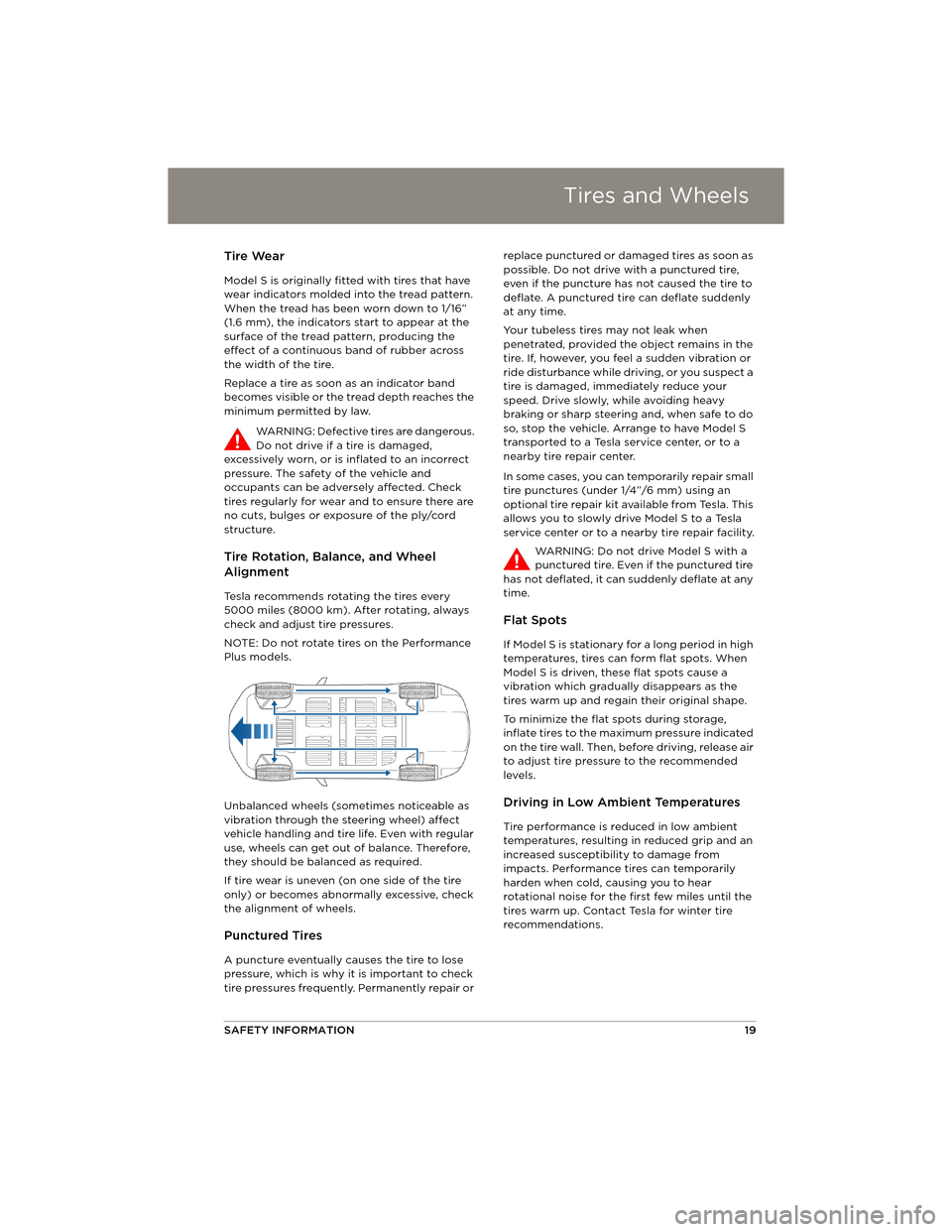
Tires and Wheels
SAFETY INFORMATION19
Tire Wear
Model S is originally fitted with tires that have
wear indicators molded into the tread pattern.
When the tread has been worn down to 1/16”
(1.6 mm), the indicators start to appear at the
surface of the tread pattern, producing the
effect of a continuous band of rubber across
the width of the tire.
Replace a tire as soon as an indicator band
becomes visible or the tread depth reaches the
minimum permitted by law.
WARNING: Defective tires are dangerous.
Do not drive if a tire is damaged,
excessively worn, or is inflated to an incorrect
pressure. The safety of the vehicle and
occupants can be adversely affected. Check
tires regularly for wear and to ensure there are
no cuts, bulges or exposure of the ply/cord
structure.
Tire Rotation, Balance, and Wheel
Alignment
Tesla recommends rotating the tires every
5000 miles (8000 km). After rotating, always
check and adjust tire pressures.
NOTE: Do not rotate tires on the Performance
Plus models.
Unbalanced wheels (sometimes noticeable as
vibration through the steering wheel) affect
vehicle handling and tire life. Even with regular
use, wheels can get out of balance. Therefore,
they should be balanced as required.
If tire wear is uneven (on one side of the tire
only) or becomes abnormally excessive, check
the alignment of wheels.
Punctured Tires
A puncture eventually causes the tire to lose
pressure, which is why it is important to check
tire pressures frequently. Permanently repair or replace punctured or damaged tires as soon as
possible. Do not drive with a punctured tire,
even if the puncture has not caused the tire to
deflate. A punctured tire can deflate suddenly
at any time.
Your tubeless tires may not leak when
penetrated, provided the object remains in the
tire. If, however, you feel a sudden vibration or
ride disturbance while driving, or you suspect a
tire is damaged, immediately reduce your
speed. Drive slowly, while avoiding heavy
braking or sharp steering and, when safe to do
so, stop the vehicle. Arrange to have Model S
transported to a Tesla service center, or to a
nearby tire repair center.
In some cases, you can temporarily repair small
tire punctures (under 1/4”/6 mm) using an
optional tire repair kit available from Tesla. This
allows you to slowly drive Model S to a Tesla
service center or to a nearby tire repair facility.
WARNING: Do not drive Model S with a
punctured tire. Even if the punctured tire
has not deflated, it can suddenly deflate at any
time.
Flat Spots
If Model S is stationary for a long period in high
temperatures, tires can form flat spots. When
Model S is driven, these flat spots cause a
vibration which gradually disappears as the
tires warm up and regain their original shape.
To minimize the flat spots during storage,
inflate tires to the maximum pressure indicated
on the tire wall. Then, before driving, release air
to adjust tire pressure to the recommended
levels.
Driving in Low Ambient Temperatures
Tire performance is reduced in low ambient
temperatures, resulting in reduced grip and an
increased susceptibility to damage from
impacts. Performance tires can temporarily
harden when cold, causing you to hear
rotational noise for the first few miles until the
tires warm up. Contact Tesla for winter tire
recommendations.
Model S Quick Guide - NA Rev C.book Page 19 Wednesday, December 18, 2013 12:40 PM
Page 22 of 44

Tires and WheelsTires and Wheels
20MODEL S
Improving Tire Mileage
To improve the mileage you get from your tires,
maintain tires at the recommended tire
pressures (see page 18), observe speed limits
and advisory speeds, and avoid:
• Pulling away quickly, or hard acceleration.
• Fast turns and heavy braking.
• Potholes and objects in the road.
• Hitting curbs when parking.
• Contaminating tires with fluids that can
cause damage.
Replacing Tires and Wheels
Tires degrade over time due to the effects of
ultraviolet light, extreme temperatures, high
loads, and environmental conditions. It is
recommended that tires are replaced every six
years, or sooner if required.
Wheel rims and tires are matched to suit the
handling characteristics of the vehicle.
Replacement tires must comply with the
original specification. If tires other than those
specified are used, ensure that the load and
speed ratings marked on the tire (see page 22)
equal or exceed those of the original
specification.
Ideally, you should replace all four tires at the
same time. If this is not possible, replace the
tires in pairs (both front or both rear). When
replacing tires, always rebalance and check the
alignment of wheels.
WARNING: For your safety, use only tires
and wheels that match the original
specification. Tires that do not match the
original specification can affect the operation
of the Tire Pressure Monitoring System (TPMS).
Asymmetric Tires
Model S tires are asymmetric and must be
mounted on the wheel with the correct sidewall
facing outward. The sidewall of the tire is
marked with the word OUTSIDE . When new
tires are installed, make sure that the tires are
correctly mounted on the wheels. WARNING: Road holding is seriously
impaired if the tires are incorrectly
installed on the wheels.
Winter Tires
In snowy and icy conditions, consider installing
winter tires. Winter tires must be the same size,
brand, construction and tread pattern on all
four wheels. For recommendations on winter
tires, contact Tesla.
WARNING: On dry roads, winter tires
could have less traction than the
originally installed tires.
Using Tire Chains
Tesla has tested and approved Security Chain
Company (SCC) Model Z-563 chains for use on
the rear wheels. These chains must only be
used if your Model S has 245/45R19 rear tires
installed. Do not use chains on 21” tires.
When installing tire chains, follow the
instructions provided by the tire chain
manufacturer. Mount them as tightly as
possible.
When using tire chains:
• Drive slowly—do not exceed 30 mph
(48 km/h).
• Avoid heavily loading Model S (heavy loads
can reduce the clearance between the tires
and the body).
• Remove the tire chains as soon as
conditions allow.
NOTE: Tire chains are prohibited in some
jurisdictions. Check local laws before installing
tire chains.
Model S Quick Guide - NA Rev C.book Page 20 Wednesday, December 18, 2013 12:40 PM